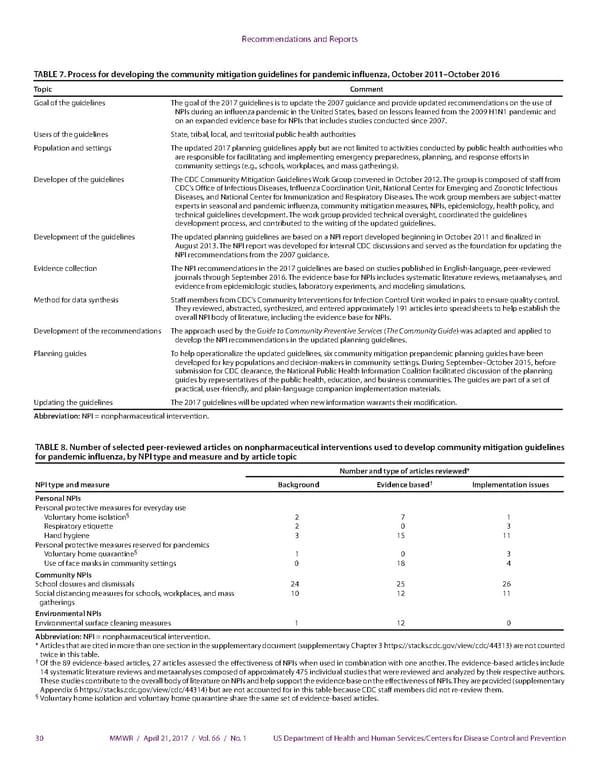Recommendations and Reports TABLE 7. Process for developing the community mitigation guidelines for pandemic influenza, October 2011–October 2016 Topic Comment Goal of the guidelines The goal of the 2017 guidelines is to update the 2007 guidance and provide updated recommendations on the use of NPIs during an influenza pandemic in the United States, based on lessons learned from the 2009 H1N1 pandemic and on an expanded evidence base for NPIs that includes studies conducted since 2007. Users of the guidelines State, tribal, local, and territorial public health authorities Population and settings The updated 2017 planning guidelines apply but are not limited to activities conducted by public health authorities who are responsible for facilitating and implementing emergency preparedness, planning, and response efforts in community settings (e.g., schools, workplaces, and mass gatherings). Developer of the guidelines The CDC Community Mitigation Guidelines Work Group convened in October 2012. The group is composed of staff from CDC’s Office of Infectious Diseases, Influenza Coordination Unit, National Center for Emerging and Zoonotic Infectious Diseases, and National Center for Immunization and Respiratory Diseases. The work group members are subject-matter experts in seasonal and pandemic influenza, community mitigation measures, NPIs, epidemiology, health policy, and technical guidelines development. The work group provided technical oversight, coordinated the guidelines development process, and contributed to the writing of the updated guidelines. Development of the guidelines The updated planning guidelines are based on a NPI report developed beginning in October 2011 and finalized in August 2013. The NPI report was developed for internal CDC discussions and served as the foundation for updating the NPI recommendations from the 2007 guidance. Evidence collection The NPI recommendations in the 2017 guidelines are based on studies published in English-language, peer-reviewed journals through September 2016. The evidence base for NPIs includes systematic literature reviews, metaanalyses, and evidence from epidemiologic studies, laboratory experiments, and modeling simulations. Method for data synthesis Staff members from CDC’s Community Interventions for Infection Control Unit worked in pairs to ensure quality control. They reviewed, abstracted, synthesized, and entered approximately 191 articles into spreadsheets to help establish the overall NPI body of literature, including the evidence base for NPIs. Development of the recommendations The approach used by the Guide to Community Preventive Services (The Community Guide) was adapted and applied to develop the NPI recommendations in the updated planning guidelines. Planning guides To help operationalize the updated guidelines, six community mitigation prepandemic planning guides have been developed for key populations and decision-makers in community settings. During September–October 2015, before submission for CDC clearance, the National Public Health Information Coalition facilitated discussion of the planning guides by representatives of the public health, education, and business communities. The guides are part of a set of practical, user-friendly, and plain-language companion implementation materials. Updating the guidelines The 2017 guidelines will be updated when new information warrants their modification. Abbreviation: NPI = nonpharmaceutical intervention. TABLE 8. Number of selected peer-reviewed articles on nonpharmaceutical interventions used to develop community mitigation guidelines for pandemic influenza, by NPI type and measure and by article topic Number and type of articles reviewed* NPI type and measure Background Evidence based† Implementation issues Personal NPIs Personal protective measures for everyday use § Voluntary home isolation 2 7 1 Respiratory etiquette 2 0 3 Hand hygiene 3 15 11 Personal protective measures reserved for pandemics § Voluntary home quarantine 1 0 3 Use of face masks in community settings 0 18 4 Community NPIs School closures and dismissals 24 25 26 Social distancing measures for schools, workplaces, and mass 10 12 11 gatherings Environmental NPIs Environmental surface cleaning measures 1 12 0 Abbreviation: NPI = nonpharmaceutical intervention. * Articles that are cited in more than one section in the supplementary document (supplementary Chapter 3 https://stacks.cdc.gov/view/cdc/44313) are not counted twice in this table. † Of the 89 evidence-based articles, 27 articles assessed the effectiveness of NPIs when used in combination with one another. The evidence-based articles include 14 systematic literature reviews and metaanalyses composed of approximately 475 individual studies that were reviewed and analyzed by their respective authors. These studies contribute to the overall body of literature on NPIs and help support the evidence base on the effectiveness of NPIs. They are provided (supplementary Appendix 6 https://stacks.cdc.gov/view/cdc/44314) but are not accounted for in this table because CDC staff members did not re-review them. § Voluntary home isolation and voluntary home quarantine share the same set of evidence-based articles. 30 MMWR / April 21, 2017 / Vol. 66 / No. 1 US Department of Health and Human Services/Centers for Disease Control and Prevention
 Community Mitigation Guidelines to Prevent Pandemic Influenza Page 31 Page 33
Community Mitigation Guidelines to Prevent Pandemic Influenza Page 31 Page 33